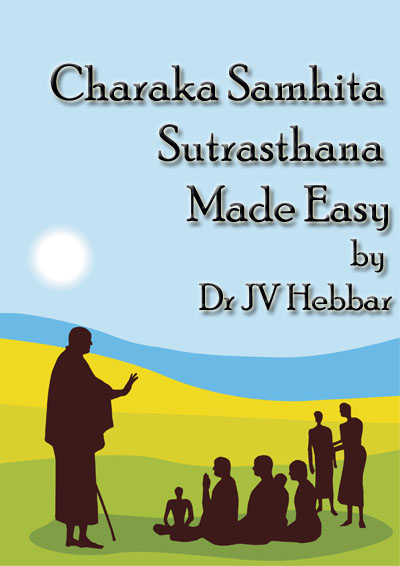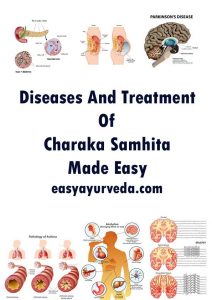Rules For Vamana and Virechana Treatment- Charak Samhita Sutrasthan 15
Requirements of a doctor to carry out proper Ayurvedic treatment include a good hospital, availability of medical attendants, instruments and medicines related with the treatment. These requirements are very essential in case of administration of Panchakarma treatments like Vamana (emesis) and Virechana (purgation) etc. The 15th chapter of Sutrasthana of Charaka Samhita is Upakalpaneeya Adhyaya. It explains about the facilities required for treatment and also about rules for Vamana and Virechana.
The physician who is going to administer Vamana (emesis) or Virechana (purgation) treatment to people of higher order, like king, should collect all requirements well in advance. If such collected materials are left over, after the treatment, those can be used in treating other patients. During treatment, if the procedures goes wrong, then these important materials and medicines can be utilized to handle the treatment complications. Hence, to avoid panic during treatment procedure, a wise physician should collect all the medicines and equipments of the treatment well in advance, though they may be available locally for sale. Thus said Lord Atreya.
Agnivesha seeks a clarification – “O Lord! A wise physician at the outset should administer the therapy in such a way that it is always accurate, without any mistakes. Effectiveness of the treatment is defined as “always infallibly effective”. Effectiveness of all actions depends on proper administration. Conversely, failure is the result of improper administration.
If the physician is not sure of the success of his treatment, and if he is anticipating a failure, then would it not indicate lack of knowledge? [3-4]
Table of Contents
Minuteness of the factors determining the result of the treatment
Lord Atreya replied, “O Agnivesha! Some able doctors can certainly administer therapy in such a flawless way. It is within our competence to impart instructions for the proper administration of therapy. But how many are there who would fully comprehend our instructions or act on them or use them properly?”
The difference in variations of the following factors are very subtle.
Dosha – the imbalanced Dosha causing disease in the treatment
Bheshaja – medicines used in the treatment,
Kala – time, season,
Bala – strength and immunity of the patient,
Shareera – nature of the body of the patient
Ahara – diet habits of the patient,
Satmya – congenial habits of the patient,
Satva – ability of the patient to tolerate the disease / treatment
Prakruti – nature, body type of the patient.
Variation of these factors in causing disease is very subtle. Hence, even a brilliant physician can sometimes create an error in judging the disease or the line and quantity of treatment. So, subsequently signs of a good treatment, bad treatment and antidotes are explained further. [5]
Hospital building
An expert architect should design a good hospital building. The building should be strong and should not be exposed to winds. It should be so constructed as to allow wind only through one passage. It should provide comfortable moving space. The building should not be situated in a mountainous place nor should it be located near a bigger building.
Besides, the building should not be exposed to smoke, the sun, water, dust or undesirable noise nor should it have undesirable contacts, tastes, sight or smell.
The building should be well equipped with a water reservoir or water pot, motor, pestle, Latrine, bathroom and kitchen.[6]
Medical attendants and other general requirements
There should be attendants who are endowed with good conduct, cleanliness, character, devotion, dexterity and sympathy and who are versed with the art of nursing and who are good in administering therapies.
Several such attendants are required for various purposes like cooking soup, porridge, etc. bathing, massaging, lifting, seating of patients and also for grinding of drugs (in preparing herbal powders, Kashayam etc). These attendants should be willing workers.
People well-versed with vocal and instrumental music, panegyrics, recitation of verses, ancient lores, short stories, epics and Purana (Mythology), those who can grasp the inner desires, who are obedient, and who have knowledge of the time and place should also be arranged.
Birds and animals
Presence of Lava (common quail), Kapinijala (Grey partridge), Shasha(Rabbit), Harina (Black Buck), Ena ( Antelope), Kalapucchaka (Black Tailed deer), Mrigamatruka (red deer), Urabhra (wild sheep) is necessary. There should be a milch-cow of good temper and free from diseases with her calf alive. Proper arrangement should be made for her fodder, dwelling and water.
Basic amenities
Provision should also be made for water vessel (Patra), spoon (Achamaniya), water tub (Udakostha), big and small earthen jars (Manika and Ghata), frying pan (Pithara), Bowl (Kunda), saucer (Sharava), Ladle (darvi), Mat (kata), Cover plate (Udanchana), cooking pan (Paripachana), Churning stick (manthana), Leather, cloth, thread, cotton, wool etc.
Does Duration For Vamanam Virechanam Vary As Per Seasons?
Facilities for Panchakarma treatment
Arrangements are to be made for beds, seats, golden vase and spittoon, bed sheet, towel, pillow and cushion. These should facilitate lying flat, sitting, oleation (Snehana), fomentation (Swedana), massage (Abhyanga), unction (Pradeha), effusion (Parisheka), anointment (Lepa), emesis (Vamana), purgation (Virechana), Asthapana type of enema, Anuvasana type of enema, elimination of Doshas from head (Shiro Virechana) and passing of stool and urine.
Herbs to manage complications of Panchakarma
There should also be smooth, hard and of medium size along with well cleared pestles, sharp instruments, accessories, smoking pipe, tube for enema and douche, broom, scales and measuring vessels, ghee, oil, muscle fat, marrow, honey, Phanita (a semisolid sugar cane preparation), salt, fuel various types of wine like the one prepared of honey, Sidhu, Sura, Sauviraka, Maireya, Tushodaka, Curd, whey, Udashvita (a mixture of water and butter milk in equal parts), Dhanyamla (Sour gruel), Shali (rice), Shastika (a variety of rice harvested in 60 days), Mudga (green gram), Masha (black gram), Yava (Barley), Tila(Sesame seeds), Kulattha (Horse gram), Badara (Ber fruit), Mridveeka (raisins), Kashmarya (Gmelina Arborea inn), Parushaka (Grewia asiatica Linn), Abhaya (Haritaki), Amalaki (Emblica officinalis Gaertn), Bibhtaka (Terminalia bellerica Roxb) and other drugs employed in oleation, fomentation, emesis, purgation, those having the combined action of emesis and purgation which are known as constipates and appetisers and ablatives of Vata etc. and are carminatives, such other medicines as are conducive to the treatment of complications, if any, and also those which are useful in and after-treatment should also be collected.[7]
Hospitalization and general plan for the treatment
The patient should then be treated by means of oleation (snehana) and fomentation (Swedana) therapies as required. In the event of a sudden attack of a more serious psychic or somatic disease during the course of treatment, the physician should try to correct the newly arrived complications first. Even after it has been corrected the corrective therapy should be continued for an equivalent duration.
Administering medicine for Vamana – Emesis Therapy
After successful administration of oleation and fomentation therapies and on ensuring that the patient’s mind has come to a balance, he has taken full bath, anointed his body, worn a garland and an untorn, clean cloth and has offered worship to the Deity, fire, Brahmana, Preceptor, Elderly persons and physician, Brahmanas should be requested to recite auspicious Mantras and bestow their blessing on the patient on an auspicious day with auspicious constellation, Date, Karana, And Muhurta (astrologically important moments in a day), thereafter, the physician should administer a dose of the decoction of the fruit of Madana (Randia dumetorum Lam). Along with Honey, Rock salt, Phanita ( a preparation of Sugar cane juice) and the powder of Madhuka– (Licorice – Glycyrrhiza glabra) [8-9]
Dose of emetics (Vamana Dravya)
मदनफलकषायमात्राप्रमाणं तु खलु सर्वसंशोधनमात्राप्रमाणानि च प्रतिपुरुषमपेक्षितव्यानि भवन्ति; यावद्धि यस्य संशोधनं पीतं वैकारिकदोषहरणायोपपद्यते न चातियोगायोगाय, तावदस्य मात्राप्रमाणं वेदितव्यं भवति||१०||
The Dosage of the Kashayam of the fruit of Madana (Randia Dumetorum Lam) and of all the other drugs used in elimination therapy should be determined according to the individual needs. In other words, the quantity, which when taken brings about the desired effect in the form of elimination of the vitiated Doshas which does not cause over- elimination or inadequate elimination, is to be regarded as the proper dose for the patient. [10]
Signs and symptoms indicating proper action of the drug
पीतवन्तं तु खल्वेनं मुहूर्तमनुकाङ्क्षेत, तस्य यदा जानीयात् स्वेदप्रादुर्भावेण दोषं प्रविलयनमापद्यमानं, लोमहर्षेण च स्थानेभ्यः प्रचलितं, कुक्षिसमाध्मापनेन च कुक्षिमनुगतं, हृल्लासास्यस्रवणाभ्यामपि चोर्ध्वमुखीभूतम्, अथास्मै जानुसममसम्बाधं सुप्रयुक्तास्तरणोत्तरप्रच्छदोपधानं सोपाश्रयमासनमुपवेष्टुं प्रयच्छेत्, प्रतिग्रहांश्चोपचारयेत्, लालाटप्रतिग्रहे पार्श्वोपग्रहणे नाभिप्रपीडने पृष्ठोन्मर्दने चानपत्रपणीयाः सुहृदोऽनुमताः प्रयतेरन्||११||
After the administration of decoction, the patient should be watched for some time.
The first effect of the administration of decoction would be perspiration which indicates that the Dosha has started melting.
After that, the patient would have horripilation (Romaharsha) which shows that the Dosha has started moving from its own position.
In the third stage the patient will have distension of the abdomen (kuskhi adhmana) indicative of the Doshas having shifted to the intestine.
Nausea and salivation which occur in the fourth stage indicate that the Dosha has started moving upwards.
Position of patient during vomiting
It is at this stage that the patient should be asked to sit on a bed of knee height, comfortable, well covered and equipped with a bed-sheet, towel, pillow and cushion. A spittoon should be kept nearby. The caretaker of the patient should support his head, sides, press the navel and massage the back of the patient.
The patient should then be instructed as follows, “Keep your lips, Palate and throat open: do not exert too much but allow the vomiting urge to be fully manifested. In case the urge is not well apparent, its manifestation will be facilitated if you slightly bend the neck and upper part of the body and touch your throat by means of two fingers whose nails have been well clipped off. You may touch your throat with the lotus stalk or Saugandhika”.
The patient should act on this advice. The physician should very carefully observe the vomit in the spittoon, ascertain the number of urges and should conclude therapy as to whether the therapy has been well administered, inadequately administered or administered in excess. It is from this observation that the physician can determine the further line of action. So he should very carefully observe the vomiting urges.[12]
Features of proper and improper administration of emetics
तत्रामून्ययोगयोगातियोगविशेषज्ञानानि भवन्ति; तद्यथा- अप्रवृत्तिः कुतश्चित् केवलस्य वाऽप्यौषधस्य विभ्रंशो विबन्धो वेगानामयोगलक्षणानि भवन्ति; काले प्रवृत्तिरनतिमहती व्यथा यथाक्रमं दोषहरणं स्वयं चावस्थानमिति योगलक्षणानि भवन्ति, योगेन तु दोषप्रमाणविशेषेण तीक्ष्णमृदुमध्यविभागो ज्ञेयः; योगाधिक्येन तु फेनिलरक्तचन्द्रिकोपगमनमित्यतियोगलक्षणानि भवन्ति|
तत्रातियोगायोगनिमित्तानिमानुपद्रवान् विद्यात्- आध्मानं परिकर्तिका परिस्रावो हृदयोपसरणमङ्गग्रहो जीवादानं विभ्रंशः स्तम्भः क्लमश्चेत्युपद्रवाः||१३||
Inadequate administration of Vamana Therapy
- Absence of vomiting or occasional vomiting
- Vomiting of the drug material only, without the vitiated Dosha
- Excretion of the drug material through purgation
- Obstruction to the vomiting urges
Signs of proper administration of Vamana therapy
- Manifestation of the vomiting urges in time
- Absence of too much pain
- Elimination of Doshas in proper order.
- The urge for vomiting will recede on its own, after the Doshas are properly eliminated.
- Proper administration is of three types, viz, sharp (Teekshna), mild and moderate depending, among others, on the quantity of Dosha eliminated.
Over administration of Vamana
- Appearance of foam in the vomit
- Appearance of blood stained vomit.
Complications of Vamana treatment
The following complications arise out of over administration or inadequate administration of the therapy.
Adhmana – distension of abdomen,
Parikartika – sawing type of pain,
Parisrava – salivation,
Hrudaya Upasarana – palpitation,
Angagraha – rigidity, and
Jeevadana – blood vomiting,
Vibhramsha – displacement of viscera of the body,
Sthamba – stiffness,
and Shrama – exhaustion. [13]
Post emesis management
After the therapy has been well-administered, the hands, feet and face of the patient should be washed and he should be consoled. He should then be asked to smoke unctuous type (Snehana Dhoomapana), eliminative type (Shodhana Dhoomapana) or alleviating type of cigar (Shamana Dhoomapana) as it suits him and then he should enter into a room which is not exposed to the wind and should lie down there.
Then he should be instructed, ‘You should abstain from the following for the whole day-
Ucchair Bhashana – speaking aloud,
Atyashana – excess eating,
Atisthana – sitting at one place for long time,
Atichankramana – walking long distances,
Krodha, Shoka – anger and grief,
Hima, Atapa, Pravata – exposure to sun, dew and stormy wind,
Yana – travelling,
Gramya Dharma – indulging in sexual intercourse,
Asvapanam nishi – Vigil during night,
Diva Swapna – sleeping during day time,
Viruddha Ahara, Asatmya Ahara – foods with opposite qualities, wrong food combinations
Ajirna Ahara – foods that may cause indigestion,
Pramita, Ati, Heena Vishama Bhojana – intake of diet exclusively having one taste, intake of diet deficient in nutritive value, or heavy or irregularly mixed up
Vega Sandharana, Udeerana – suppression or forcible initiation of natural urges. [14-15]
Diet regimen after Vamana treatment
- In the same evening or the next day after Vamana, the patient should take a bath in lukewarm water.
- He should be given like- warm gruel (Manda) prepared with well cooked old rice. The gruel should be very thin. This is to be given with due regard to the power of digestion, for three meal-times.
- For the fourth meal- time, gruel prepared with rice (Vilepi), well-cooked, warm and devoid of oil / ghee and salt altogether or with oil / ghee and salt in small quantities is to be given. Warm water is to be taken after the intake of gruel.
- The same type of diet is to be continued for the fifth and sixth meal-times.
- For the seventh meal-time again, well-cooked porridge (odana) prepared with the same type of rice of two Prasruta along with a very thin green gram soup (Mudga yusha), added with oil / ghee and salt in small quantities is to be given.
- Warm water should be taken after the intake of the porridge. The same diet is to be repeated for the eight and ninth meal-times.
- For the tenth meal-time, thin meat-soup (Mamsarasa) of common quail (Lava), grey partridge, (Kapinjala) etc, prepared with water and salt should be given. Warm water is to be taken after this.
- This is again to be repeated for the eleventh and twelfth meal times. Thereafter, the patient should take food having different tastes and he should start taking his normal diet from the seventh night.[16]
Virechana – Purgation Therapy
After the post- therapeutic deictic program, after Vamana, oleation (Snehana) and fomentation therapies (Swedana) should be administered again.
After the patient has come to normalcy, has rested for a while and the food taken by him has been digested, he should be asked to offer oblations, chants and worships and to recite auspicious chants and expiatory verses.
The Brahmanas should then be invited to recite the auspicious Svasthivachanas on an auspicious day with auspicious constellations, Karana and Muhurta.
The patient should thereafter be given the drink of the paste of Trivrit (Operculina turpethum R.B) in one aksha (12 g) dose after stirring and mixing up. The difference in the variation of Dosha, medicinal drugs, location, time strength, body diet, wholesomeness, mind, constitution and age should be kept in view while administering this therapy.
After the patient has been administered purgation therapy, the entire regimen (prescribed to be followed after Vamana therapy (except smoking) should be followed till he regains the normal strength, complexion and health.
After he has regained mental and physical balance, has rested a while and the food taken by him is fully digested, he should take a full bath, apply unction, wear garlands, clean clothes and favourite ornaments and thus appear before friends and kinds. Thereafter, he should be free to lead a normal life.[17]
The above mentioned process is to be followed while administering elimination to resourceful persons like kings and others of an equivalent status.[18]
Plan for Emergency Management
A poor man, in the event of an emergency necessitating the administration of the elimination therapy should take the prescribed medicines available without caring for collecting all the rare medicines in advance. All the prescribed medicines are not available to all human beings. At the same time diseases can attack even the poor. So in the case of emergency, whatever drugs, cloths, diets are easily available should be used by patients according to their capacity.[19-21]
Good effects of Elimination Therapy
मलापहं रोगहरं बलवर्णप्रसादनम्|
पीत्वा संशोधन सम्यगायुषा युज्यते चिरम्||२२||
Elimination therapy eliminates the Doshas, eradicates diseases and restores normal strength and complexion. If administered properly, it ensures longevity.
To sum up:-
All the requirements for administration of elimination therapy to resourceful persons like kings, etc. their utility, the dose, signs and symptoms of inadequate administration, proper administration, and over administration, the afflicted Doshas, the complication, regimen prescribed during the therapy and those prescribed in the course of the post- therapeutic program- these has all been explained by the lord Punarvasu in this Chapter.[23-25]
Thus ends the fifteenth chapter on “requirements of a Physician “ of the Sutra section of Agnivesha’s work as redacted by Charaka.













One comment on “Rules For Vamana and Virechana Treatment- Charak Samhita Sutrasthan 15”
Dr J V Hebbar MD(Ayu)
Please check with your doctor. It depends on the disease.
Green gram, black pepper kichdi with rice kanji should be good.
Read more about Virechana here – https://www.easyayurveda.com/2014/10/10/virechana-therapy-right-method-side-effects-management/